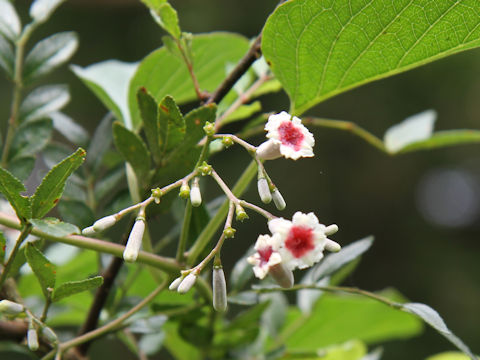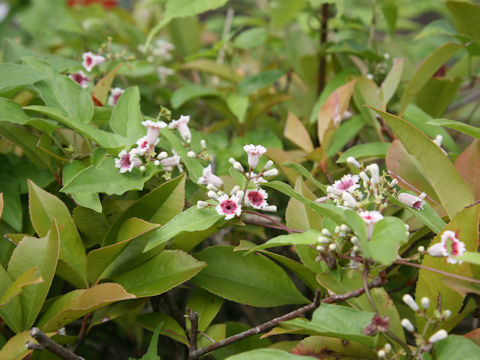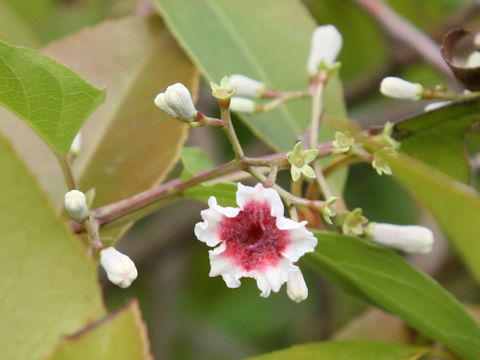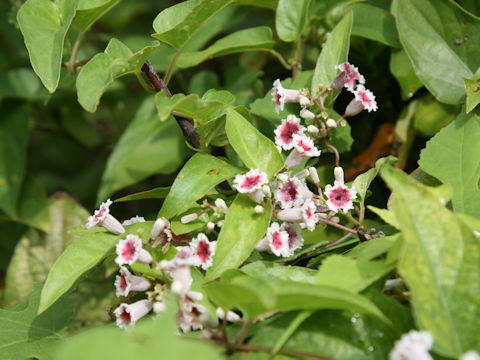
|
|
|
|
−− もっと見る(Show more)−−
−− 閉じる(Close) −−
|
|
|
|
わが国の各地をはじめ、台湾や朝鮮半島、中国に分布しています。日当たりのよい藪や草地に生え、ほかの草木に絡まって伸びます。葉は楕円形または長卵形で、対生します。8月から9月ごろ、葉腋から短い集散花序をだし、灰白色の花を咲かせます。咽と内側は紅紫色です。葉を揉むと独特の臭気があります。花を水に浮かべたかたちから「さおとめばな(早乙女花)」、花の真ん中がお灸のあとに似ていることから「やいとばな(灸花)」とも呼ばれます。台湾華語では「雞屎藤」、中国語では「雞矢藤(ji shi teng)」と呼ばれます。 |
|
|
アカネ科ヘクソカズラ属の多年草で、学名は Paederia scandens (syn. Paederia foetida)。英名はありません。 |
|
|
The "Hekuso-kazura" (Paederia scandens) belongs to Rubiaceae (the Madder family). It is a perennial herb that is native throughtout Japan, as well as Taiwan, the Korean Peninsula and China. This herb grows in sunny thickets and grasslands, and climbs up adjascent shrubs and trees. The leaves are elliptic or long-ovate and arranged in opposite. The short cymes are borne on the axils, and the grayish-white flowers bloom in August and September. The throat and inside of corolla is magenta. The leaves smell distinct odor when they are crushed. It is also called "Saotome-bana" because of the shape of the flower floating on water, and "Yaito-bana" because the center of the flower looks like the aftermath of moxibustion. In Taiwanese Chinese, it is called "雞屎藤", and in Chinese "雞矢藤" (ji shi teng). |
|
|
[上・中1] 茨城県神栖市土合北にて、2009年09月09日撮影。 [中2・中3] 茨城県つくば市「つくば実験植物園」にて、2009年08月01日撮影。 [中4・中5] 大阪府交野市「大阪市大付属植物園」にて、2005年07月27日撮影。 [中6・中7] 大阪府四條畷市逢阪「むろいけ園地」にて、2006年08月30日撮影。 [中8] 静岡県浜松市「浜松市フルーツパーク」にて、2005年11月19日撮影。 [中9] 大阪府千早赤阪村水分「金剛山」にて、2005年10月13日撮影。 [中10〜中12] 茨城県桜川市「筑波山」にて、2014年08月23日撮影。 [中13・中14] 沖縄県沖縄市にて、2016年10月01日撮影。(photo by Yumi Gunji) [中15・中16] 同上にて、2016年11月01日撮影。(photo by Yumi Gunji) [中17] 福島県会津若松市東山町「背炙り山」にて、2020年03月21日撮影。 [中18〜中21] 宮城県川崎町支倉にて、2020年08月07日撮影。 [中22〜中26] 宮城県仙台市青葉区「台原森林公園」にて、2023年09月05日撮影。 [中27・下] 宮城県村田町「城山公園」にて、2024年08月20日撮影。 |

|
|
Shu Suehiro |




























